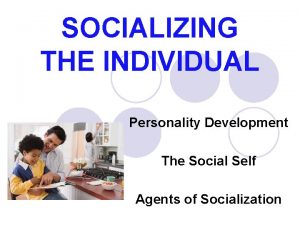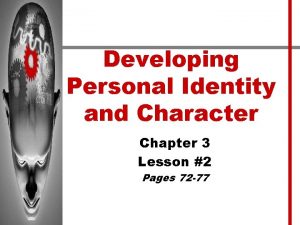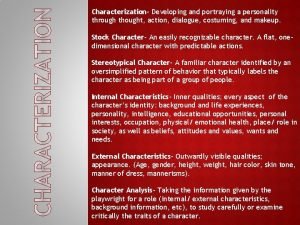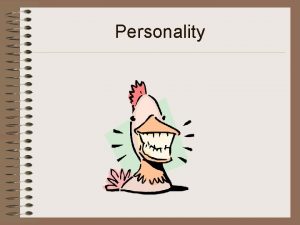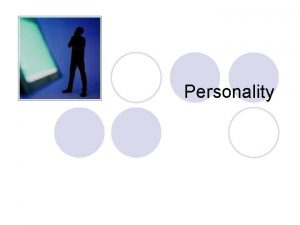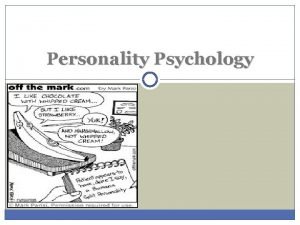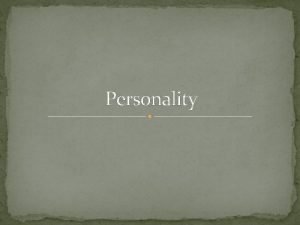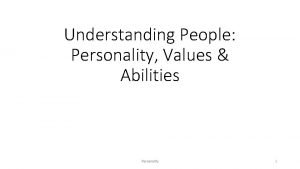Characterization Developing and portraying a personality through thought





























- Slides: 29

Characterization- Developing and portraying a personality through thought, action, dialogue, costuming, and makeup. Stock Character- An easily recognizable character. A flat, onedimensional character with predictable actions. Stereotypical Character- A familiar character identified by an oversimplified pattern of behavior that typically labels the character as being part of a group of people. Internal Characteristics- Inner qualities; every aspect of the character’s identity: background and life experiences, personality, intelligence, educational opportunities, personal interests, occupation, physical/ emotional health, place/ role in society, as well as beliefs, attitudes and values, wants and needs. External Characteristics- Outwardly visible qualities; appearance. (Age, gender, height, weight, hair color, skin tone, manner of dress, mannerisms). Character Analysis- Taking the information given by the playwright for a role (internal/ external characteristics, background information, etc), to study carefully or examine critically the traits of a character.


LESSON OBJECTIVES: The student will: • Understand the process of characterization. • Begin to create stock and stereotypical characters. • Create original characters. • Develop skill portraying the internal and external attributes of characters. • Use analysis in developing a character.

• Get in a circle. • Taking turns, each one of you will physically and vocally create an imaginary character whose name begins with a particular letter of the alphabet. • Ex- “My name is Abby, I’m from Atlanta, and I like apples!”

• Pretending to be someone else is a game that most of us have played. - Most of us have participated in this form of characterization called pretending. • In theatre, however, characterization involves much more than just pretending to be a character in a scene or play. - It also involves making others believe that you are someone else. • Whether you have created your own original character or are portraying a role written by a playwright, your job as an actor is to make the character real for the audience.

• One of the most exciting parts of theatre is to have the opportunity to “try on” and experiment with different characters. - Professional actors know that there are techniques they can use to make the characters they play seem real. • These trained actors know that their inner thoughts and outward actions work together to develop a character that the audience believes in.

Sometimes when you watch a play, movie, or television program, you recognize a character type and automatically know how that character will act. Many of the popular 30 minute situation comedies (sitcoms) on television have character types that are easy to recognize. These character types are known as stock characters and stereotypical characters.

A stock character is a familiar character who is the same type of character in every play. Stock characters were an important part of the commedia dell’arte style of theatre. The audiences of the 1500 s quickly identified each character based on what they had seen the character do or say in previous plays. Characters such as the villain, the hero, the clever servant, the fool, and the heroine were expected to appear in play after play, always looking and acting the same way.

• Commedia dell’arte was a form of improvisational theatre that began during the Renaissance, in the early sixteenth century. • Troupes of actors toured the Italian countryside, performing anywhere they could find an audience.

• Each troupe had a set of stock characters, familiar characters, who appeared in most plays. �Characters such as Pantalone, an old man Arlecchino/ Harlequin, the clever prankster Pulchinello, the maliscious servant are examples of exaggerated stock characters. These comic characters were easy for the viewers to identify dressed in their leather masks, half masks, or special costumes.

• Other characters such as the young hero, the heroine, and the fontesca, a serving maid, were left unmasked.

• The plot for the story was usually based around the lives of the young hero and heroine, who were very much in love. • Problems occurred when the heroine’s grumpy old father tried to hamper their romance. • The zanni, male servants, and the Fontesca, created comedy by helping or hindering the couple’s courtship.

• Performers in the commedia dell’arte memorized a basic outline for the action: however, dialogue was improvised, created on the spot without a script. • Audiences in the 1500 s enjoyed this style of theatre and were always eager to watch a performance.

Another type of character that we often see played by beginning actors is the stereotypical character. A stereotypical character is a familiar type of character whose tag, or label, identifies a particular group or segment of society. If the labels “politician, ” “cheerleader, ” “nerd, ” “lawyer, ” and “jock” automatically bring to mind visual images, then those particular character types have probably become stereotyped for you.

The stereotypical picture that many of us have of a grandmother is a gray-haired old lady wearing sturdy shoes and a knitted shawl. But how many grandmothers do you know who fit this picture?

When creating characters, it’s important to avoid negative ideas concerning occupation, race, gender, age, ethnic heritage, or religion. Negative stereotypes result when groups of people or individuals are misrepresented in a discriminatory or prejudicial way.

� Beginning actors find stock and stereotypical characters an easy starting point, choosing to portray characters from books, plays, and movies -If you recreate the role of the class clown, the helpful policeman, the spoiled brat, or the teenage bully, you have an idea of what to do and how to act, because you have seen these characters played many times before.

-Think of the way you would use your body and face to physically create a frozen statue of these modern stock and stereotypical characters: Psychiatrist Handsome movie star Cowboy/ hero Rich socialite Miserly business man Secret agent Clumsy waiter Photographer Attorney Traffic cop Baby sitter Newspaper reporter Dentist Fashion model School principal Private detective Flight attendant Mad scientist Rock star Librarian

As you continue your study of characterization, you will move beyond stock and stereotypical characters to ones you create on your own. These are known as original characters.

One of the most important skills you can develop is the ability to observe real people. Observing real people in real situations will help you to develop original characters. Your purpose in observing is to “collect” as many different qualities as you can. As you begin to “people watch, ” your memory bank will become a virtual storehouse for all the wonderful ideas you will collect. By borrowing bits and pieces from many different characters, you can actually create a whole new being. Then use your own mind, voice, body, face, and imagination to give your own interpretation of the character.

When you observe people, you will first notice their outwardly visible qualities, or external characteristics. Look at your classmates. What are the different components of their appearance? Your answer probably includes age, gender, height, weight, hair color, skin tone, and manner of dress. Next, notice the posture and stance of students in our class. Do they stand tall and straight or slouched and slumped? Do you notice any particularly interesting forms of posture?

Take special note of interesting habits. When simple behaviors such as nail biting, raising an eyebrow, or twisting a lock of hair are unconsciously repeated, they are called mannerisms. Certain mannerisms may become associated with a particular character. Whenever we see this character, we expect to see the familiar mannerisms as well.

Your goal as an actor is to look beyond one-dimensional stock or stereotypical characters and create a character who is complex and three-dimensional. The dimension, or depth, of a character is based on what’s inside him/ her. In addition to thinking about how your character looks, you also need to think about your character’s inner qualities— the internal characteristics. These internal qualities include every aspect of the character’s identity: background and life experiences, personality, intelligence, educational opportunities, personal interests, occupation, physical/ emotional health, place/ role in society, as well as beliefs, attitudes and values, wants and needs.

Desires, thoughts, feelings, reactions—these are all internal characteristics that are revealed as you get to know the character. It’s like becoming friends with a new acquaintance: it takes time and careful study. In 335 B. C. , Aristotle, an important Greek philosopher, defined character as the sum total of an individual’s actions. In theatre, it is the actor’s responsibility to use words and actions to explain to the audience what the character is doing and why. When the actor is able to think the inner thoughts of a character and react as the character would in a given situation, then the audience is able to see and believe.

Once you have developed your original character, you will want to be sure that the character can come alive vocally. A character’s voice is easier to discover after you have established the external and internal characteristics. Actors need to be able to adapt their own voices to reflect those characteristics.

You will want to listen to as many voices as possible. For each voice, notice the quality and tone, the patterns of speech, and the accent or dialect. The illusion of a character can be totally lost if the character’s voice is not suitable or appropriate. For example, if you have created a meek, sweet-hearted character, you will want his/her voice to reflect that. You will need to decide if a soft, soothing voice is more appropriate than a strong, stern one.

Listen to teachers, friends, television personalities, and public figures to hear the special qualities in each voice. As you listen to different voices, take notes about the way that they sound. Professional actors often work with recordings of dialects and accents to achieve vocal variety, master a particular vocal quality or tone, and build a collection of voices. Many actors study for years with vocal coaches or voice teachers to enhance their voices.

• Why is it important to become familiar with both the internal and external characteristics of a character? • How can character analysis help you to develop a character and enhance the believability of your performance? • How can you use the processes of character analysis in your other school subjects?

Interview Use the attached Character Analysis Questionnaire as a guideline to create questions for an interview of an original character. The performance of the “interview” should give the audience insight into your character’s internal and external characteristics. (Include at least 10 -15 questions). Visual Aid Create a visual aid defining and illustrating both stock and stereotypical characters. Include pictures, descriptions, and examples. Character Analysis Complete the attached Character Analysis Questionnaire for one of the characters from the play that we read last week. All questions should be answered in complete sentences with correct spelling and grammar.
 Complete or incomplete thought?
Complete or incomplete thought? Adolescent egocentrism
Adolescent egocentrism The developing person through childhood 7th edition
The developing person through childhood 7th edition The developing person through childhood and adolescence
The developing person through childhood and adolescence Transient exuberance definition
Transient exuberance definition 5 agents in developing personality
5 agents in developing personality Characterization direct and indirect definition
Characterization direct and indirect definition Indirect characterization
Indirect characterization The developing person through the life span 9th edition
The developing person through the life span 9th edition Global vision marketing definition
Global vision marketing definition The developing person through the lifespan
The developing person through the lifespan Developing talent through a growth mindset
Developing talent through a growth mindset Breadth and scope of international marketing research
Breadth and scope of international marketing research The developing person through the life span 9th edition
The developing person through the life span 9th edition The developing person through childhood 7th edition
The developing person through childhood 7th edition Developing a global vision through marketing research
Developing a global vision through marketing research Developing a global vision through marketing research
Developing a global vision through marketing research Disadvantages of timber conversion
Disadvantages of timber conversion Through one man sin entered the world, and through one man
Through one man sin entered the world, and through one man Furcation dental definition
Furcation dental definition Throwing giant scorpion shadows
Throwing giant scorpion shadows Total product offer
Total product offer Pretest: developing an academic and career plan
Pretest: developing an academic and career plan Difference between developing and underdeveloped countries
Difference between developing and underdeveloped countries Chapter 8 training and developing employees
Chapter 8 training and developing employees Transnational crime and the developing world
Transnational crime and the developing world Your personal identity who are you
Your personal identity who are you Developing personal identity and character
Developing personal identity and character Developing null and alternative hypothesis
Developing null and alternative hypothesis Examples of indirect guidance in a classroom
Examples of indirect guidance in a classroom





